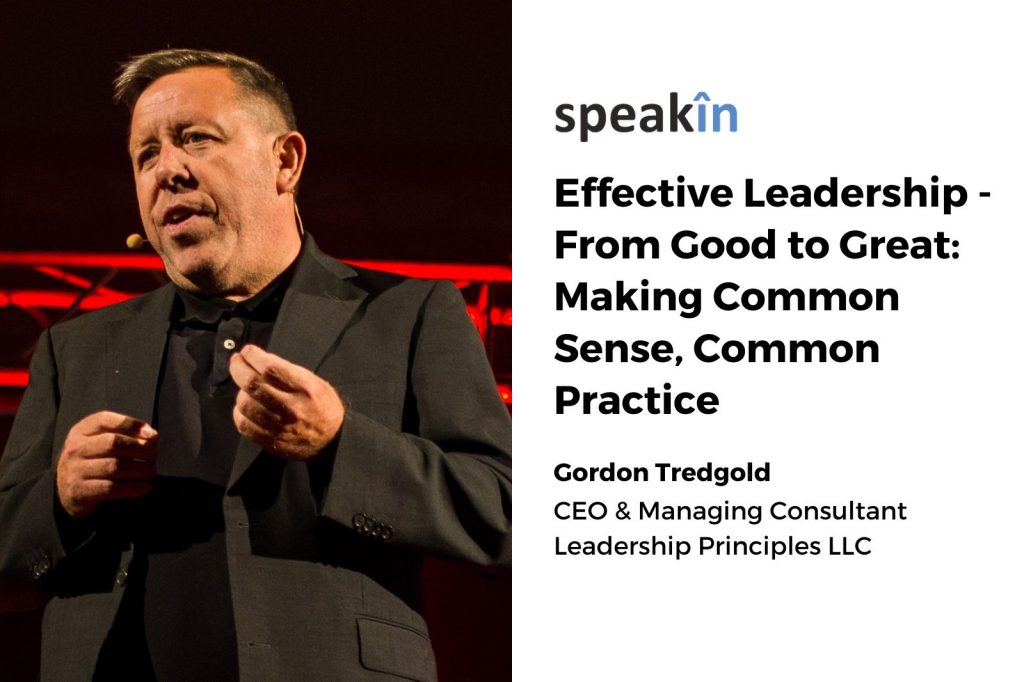Effective Leadership From Good to Great: Making Common Sense, Common Practice

In today’s rapidly changing business landscape, effective leadership has become more crucial than ever. As organizations strive to navigate uncertainties, embrace innovation, and foster growth, the role of a leader has evolved from being simply a decision-maker to becoming a catalyst for inspiration, collaboration, and progress. In this dynamic environment, leaders must continually refine their skills, expand their perspectives, and cultivate their innate potential.
It is a pleasure and honor to have this conversation with Gordon Tredgold, who developed a highly successful and proven FAST Approach that simplifies solutions, increases engagement and accountability, and to deliver results.
Share your background with us and how you became one of the most sought-after leadership experts and speakers?
When I was younger, I had two passions: Rugby. I loved sport, I loved competing, and I was a mathematics student, so I did mathematics at university. I’m very competitive and I’m very analytical. Once I started my professional career, I worked in IT, started a programme, but then got involved in projects. And I found that the way to advance the fastest, was to take on those difficult projects that nobody else wanted to do. The ones that people thought, wow, that’s got a high chance of failure, let’s keep out of that. But with my competitive nature and my analytical ability, that was an area in which that thrived. It allowed me to go in and when people think it’s going to fail, they’re quite happy for you to change the approach. For me, it was low risk, because if it fails, it’s no surprise every thought was going to fail anyway. But if you succeed now, you’re a star. So for me, I saw that as the way to accelerate my career. And I started delivering a lot of complex projects. This sounds very egotistical, but I say it this way for a particular reason, but, it was my own capability and skills which allowed me to drive and deliver projects.
Gordon’s FAST Approach
That started me to then go down the leadership path and get a much more detailed understanding of how I was more into people, so I could then expand that approach. FAST was a solution that came to me because taking on difficult projects, I got a reputation, which then got me brought into projects that were failing to turn them around and my analytical nature got me to ask the question – Do I have a process I’m following subconsciously? If I do, can I pull that out, break it down step by step so I can then share it and teach it to others?
And that’s where FAST came from and another one of my strengths is simplicity. So what I’m going to say sounds really simple, but it’s an absolute fact. As a turnaround expert, I only do two things.
First, I found out what’s wrong. Second, I fix it. That’s the approach. I know that sounds really simplistic, but it’s important to understand because then that leads to the next question: Are there common reasons why things fail?
Common Reasons Why Things Fail
- Lack of Focus
When I did the analysis of that, I came up with four reasons why things fail which make up FAST. The first one is a lack of focus. People don’t know what the goal and objective is. So if you lack clarity around the target, how can you hit it? - Accountability
The second one is about accountability and that’s about the “who”, have we communicated to people what we expect of them? Because if we haven’t told them what we expect, how can they do it? And how are we sure that we’ve given them the tools to do the job? - The “HOW”
The third part is about the “how”. We fail because we don’t know how to achieve success. We set off on a journey where the destination is unsure and the route is even less clear. Which is a guarantee for failure. So have we communicated how we’re going to deliver it? And do people believe it? Because if people believe their approach is going to be a success, they’re going to be engaged. If they’ve got the tools to do it, they’re going to be able to do it. If they know what success looks like, they can aim for it clearly. - Transparency
Do we know what’s involved and have we set ourselves up for success? If you and I want to have a baby, it takes nine months. If we decide we want to do it in six months, because that sounds like a good idea, that’s not going to work. It takes nine months. So we need to be clear about – have we given ourselves enough time to succeed? Think, Act, Do – Simple steps to ensure success and save costs. Gartner says that projects tend to cost three times as much and take three times as long as initially estimated. So if that’s true, the majority of projects have failed before they even start. So we need to know what the goal is. We need to make sure we’ve given the people involved clear instructions and the tools. We need to be clear about “we know how” we’re going to be successful and people believe it and then we need to be clear that we set ourselves up for success.And the last part of transparency is, do we have a feedback mechanism that shows us after 50% of the time, we’ve achieved 50% of the goal or we’re 50% off the way to the target? Because if we have that feedback loop, that’s going to motivate us as we start to see ourselves progress and then when we get within touching distance, people become excited and work even harder.
That whole principle is what makes it my FAST approach.
And yes, it helps deliver better results. But also if people are confident that the job can be done and they have the tools to do it, they’re going to be engaged. Everybody wants to be successful. When you have that FAST mindset, you create teams that are excited and who are proud of what they do and want to do even more.
I use a lot of quotes because another one of my strengths is to be able to explain things in a way that people can understand or get them to think a little bit differently.
And Einstein, who was one of the smartest men in the world, said:
“If he had an hour to save the world he would spend 55 minutes understanding the problem and five minutes working on the solution.”
Because if he’s got the right problem, then when he applies his solution, he’s going to be making progress. But we live in a very fast paced world where we get about a minute to think about the problem and then we’re just told to execute. But if we’ve misunderstood it ever so slightly, now we’re solving the wrong thing, we’re working towards the wrong goal and failure is going to be the outcome. Another quote from Peter Drucker is that:
“Management is about doing things right. Leadership is about making sure we’re doing the right things.”
So as leaders, it’s our job to take that step back, to take the time to be sure we know what the problem is and the solution is to communicate to our teams. And if we do that, we’ll increase team effectiveness tremendously. I mean, it’s simple to do, but it’s difficult sometimes to find the time to do it because we’re told “go, go, go”. And if we don’t stop and ask “where”, we might set off in the wrong direction.
There’s another thing that’s interesting, and this is one of the things I talk about on accountability. According to IBM research on projects that failed, what percentage of the time did the teams know from day one that the project had no chance. So how often did people know from day one the project was going to fail?
75%. There’s a simple thing we could do. Do you know what that is? Communicate – ask our teams, do you think this will fail? And if they say yeah, we ask them. Why? And if they tell us it’s a lack of resources, provide the resource. If they say it’s a lack of time, provide more time. And one of the things I talk about with accountability is that I cannot make you accountable. I can make you responsible. I can say, this is your job. But accountability is taking ownership. And when we take ownership, it’s the person’s decision whether to take it or not. So I can’t make you take ownership. But there’s one thing I can do to increase the probability that you’ll take ownership, and that’s to ask you:
Do you have everything you need to be successful?
When you say yes, now you’ve taken ownership because you’ve just told yourself, I have everything I need.
And also you’ve just told yourself, I can do this. I’m going to be successful. But a lot of people don’t want to ask that question. And they tell me, but what if the person says no? I said, well, that’s your job. You’re accountable as their leader to set them up for success. And if you haven’t given them enough time, the resources, skills or training and they fail, you’re accountable for that failure, not them.
So a lot of this is very simple, but people just don’t do it. And I think sometimes it’s just as I said, we’re under so much pressure to act that it should be: Think, Act, Do. Not Act, Think, Redo. That’s why things fail and that takes more money, because we’re in that act, think redo mod. And another quote I like, or a phrase I use is:
“There’s never enough money to do it right, but we always find the money to do it again.”
So why not just find the money to do it right?
Bringing Back The Common Practice in Leadership
I’d like people to perceive me as an expert. I would love that. But a lot of the things I’ve shared are just common sense, but they’re not common practice. And we need to bring common sense back into common practice. And everything I’m talking about, yes, I have a degree in mathematics, which implies a level of intelligence, but there’s nothing I’ve said that is impossible for anybody else to do. They’re simple things. Another great phrase I like, this comes from tailoring:
“Measure twice, cut once. If you measure once and cut once, you might have cut the wrong thing. So measure twice, cut once.”
So that’s about that. Think, think again and then take action. We prevent mistakes. We can avoid avoidable mistakes. And when you do that, you will progress faster. You will achieve success quicker. Less stressful, less burnout. We talk about engagement, and if a team thinks it’s going to fail. They’re not going to be engaged, why would I engage in failure? And if I’m not engaged, even if I think it’s going to fail, but actually it’s a chance of being successful, if I’m not engaged, it’s going to fail.
We’ve almost guaranteed failure by thinking, this will fail. So your team is thinking from day one, this will be successful. Or, yeah, this could be successful. So when we start the journey, if things start to fail, people go, oh, my God, let’s fix it. Whereas if they think it’s going to fail and it starts to fail, they just go, “Told you. Told you this is going to happen.” And they become spectators of a failure rather than participants in finding solutions.
This is common sense truth. And this is why I’m a popular and sought after leader, because when I come in and work with teams, you start to see a transformation really quickly, because teams go from I can, to we could to, we can, and the momentum is different. The culture, the atmosphere within the team is different. The thing about our brains is they’re ridiculously powerful. And if you have your brain looking for reasons why this will fail, it will find them.
If you have your brain looking for, “how can we make this work?” It will find a way. We need to make sure we have people in that positive solution mindset rather than negative. There are no positive outcomes of negative thinking. Positive thinking, it won’t always lead to my positive thinking that I’ll be the best player in the National Basketball Association. Whilst I’m positive about that, me being 5ft, five inches tall might stop me from doing that. So not every positive thought is going to deliver a positive outcome, but every negative thought delivers a negative outcome, everyone. So we’ve got to get our teams thinking positively about themselves, about the project, and when they do that, they’re engaged. We’ll drive results, we’ll drive operational performance. So all of these things are interlinked: Happy people, productive people, productive people are happy people.
So we just got to get that circle. Either make them happy to get them productive and then keep them productive to keep them happy. And once you do that, the sky’s the limit.
Where’s The Problem?
Leadership defines culture. So it’s the leader’s job to start thinking about “how can I put my teams in a position where they can be successful?”
- Employee Engagement Starts From…Who?
When I do leadership training and I talk about engagement, who’s accountable for our employee engagement? And you look at all of the statistics that come out, and if it’s America, there’s 33% engaged, 67% not engaged. Worldwide, it’s 15% engaged, 85%. I don’t believe that. I’ve worked in multiple countries. It’s about the same. So let’s go with the two thirds engaged. And every time we do that, managers run programs on how employees can be more engaged.But it’s the manager’s job to engage the people. If you let them know why what we’re doing is important, how they’ll benefit, you let them know how to do it and give them the tools, they will be engaged. If you don’t do any of those three things, why should I engage? You don’t care. I don’t care. And there’s an even more interesting staff. Gallup seems to have stopped measuring this, and I suspect it’s because there’s no market for it.But employee engagement in America is at 33%. Do you know what percentage management engagement is? It’s 30%. But managers don’t want to hear it’s my fault. And that’s why we keep doing employee engagement services. It’s not me. It’s them that’s not engaged. But you have to engage them. And when you engage them, they will become engaged if you don’t engage them. And sending an email or issuing a command is not the same as engaging people.Engaging them is letting them know why this is important, how we’re going to do it, and then asking them, do you have the tools to do it? When you do those three things, people will become engaged. It’s as simple as that. But people don’t want to do that. I’m the boss. I just want to: “We’ve hired you to be successful. Go be successful.” That’s not how it works. People need to be motivated. Money, salary gets them through the door.Leadership motivates them to be successful. Sorry to say that if your team’s not performing again, this is a saying I always use, and people don’t like it, but I don’t care. Every time somebody tells me I have a bad team, what I hear is, I’m a bad manager. - Fix the problem not the Symptoms
But if you’re constantly looking at the symptom and trying to cure the symptom, you’re never going to be successful. That’s the wrong focus. We’ve got to fix the problem, not the symptom. And when you look at why people fail, I’ve done a lot of research on this and investigation. A lot of that with people that I’ve worked with.When you look at reasons why people fail, they don’t have the skills. That’s my fault. I shouldn’t have given them a job they’re not capable of doing.
They don’t have the time. That’s my fault. I should have given them the time to do the job.
They don’t have the tools. That’s my fault. I should have given them the tools.
They don’t have the resources. I should have given them the resources.
They don’t understand what it is that’s needed. That’s my fault. And then the other reason why they might fail is they can’t be bothered.Only one of them is their fault, and it’s “I can’t be bothered”. And even that, if I paint bright enough vision, I should be able to get you to be bothered. But even in that case, even when you can’t be bothered, that’s the point at which we should be looking at getting rid of people. But we have to fix the other five things first. But people don’t do that. They see that person underperforming, they criticize them, they watch them again, they see them underperform two times, three times, and then they fire them rather than fixing the problem.And when you bring in somebody new, if you haven’t fixed the problem, it’s just going to repeat. Yeah, I mean, as I say, there’s nothing insightful about this. It’s basic, fundamental common sense. But people don’t do it. People just don’t do it. Common sense ain’t common practice.
4 Tips To Improve Your Leadership
- Smile more
When we smile, we make ourselves more approachable, more accessible. It reduces stress in ourselves. It instigates a smile into the person. When I said that, you smiled. That reduces the stress in them. So we’ve now created a less stressful environment where we feel more approachable. - Listen more
When we listen to people, we are showing respect. We are engaging them because by virtue of listening, we’ve probably asked the question. So we started that engagement. And when we listen, we show respect. When we respect people, they will respect you more. It shows that we have trust in them and we want their contribution. And we might learn something. - Talk more
Tell people what our goals and objectives are, why we are doing what we are doing. What’s the progress that we’re making to give people feedback? Because when we do that, they have a better understanding. It allows them to make better decisions. And they’re going to trust us more when they understand why we’re doing what we’re doing. - Praise more
And then the last thing is praise more, give people positive feedback, even if it’s, oh, wow, your hair looks great today. People say flattery gets you nowhere. Sorry, Flattery gets you everywhere. As long as it’s sincere. So we should be calling out, good performance, good behavior. And when we recognize people, what gets recognized gets repeated when we leave a tip. In a restaurant. We’re doing it for two reasons. One, we’re thanking them for the good job that they’ve done, but also we want them to remember us when we come back so they’ll do a good job again.
So recognition isn’t just about what you’ve done. It’s also about what you’re going to do next. And what gets recognized gets repeated. Four simple things you could do right now to improve your leadership: Smile more, listen more, talk more, praise more.
You do not need a PhD in leadership to do any of those. Every single person can do those. And if you’re not doing them, it’s a choice. You are choosing to be a poorer leader. Making common sense, common practice. Great is achievable providing you start the journey. If you never start the journey, you’ll never be great.
About Gordon Tredgold
Gordon Tredgold is a former corporate leader who has successfully delivered complex projects, led global teams, and helped clients reduce operational costs and increase performance. He is a highly sought-after keynote speaker on leadership, employee engagement, and operational excellence, and has been recognized as a ‘Top 10 Leadership Expert and Speaker’ by Global Gurus. Gordon’s work has been featured in various top publications, and he has written four books, including a finalist in the Chartered Management Institute Management Book of the Year. With his background in mathematics, Gordon has an innate ability to simplify complex situations and come up with practical solutions. He preaches simplicity in everything he does, which helps empower and excite people and gets them to take action. Gordon has developed a highly successful and proven FAST Approach that simplifies solutions, increases engagement and accountability, and helps deliver results for clients including Accenture, GE Aviation, Allianz, Baxter International, and American Airlines, among others.





